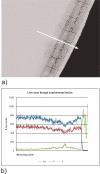EDX-Element Analysis of the In Vitro Effect of Fluoride Oral Hygiene Tablets on Artificial Caries Lesion Formation and Remineralization in Human Enamel
- PMID: 21687564
- PMCID: PMC3115601
- DOI: 10.2174/1874210601105010084
EDX-Element Analysis of the In Vitro Effect of Fluoride Oral Hygiene Tablets on Artificial Caries Lesion Formation and Remineralization in Human Enamel
Abstract
Aim of this in-vitro-study was to assess the remineralization potential of a tooth cleaning tablet with different fluoride content quantitatively using EDX analysis.Twenty three caries free impacted third molars were examined; enamel surfaces were wax coated leaving two 3x4mm windows for exposure to demineralization/remineralization cycles. The teeth were randomly assigned to 4 groups of 5 control and 6 experimental teeth each. Demineralization by standardized HEC-gel, pH 4.7 at 37°C for 72h, was alternated by rinsing in remineralization solution, pH 7.0 at 37°C for 72h, total challenge time 432h. The negative control group N was treated during remineralization cycles with saline; positive control group P was treated with remineralization solution; experimental group D1 was exposed to remineralization solution containing Denttabs(®)-tablets with 1450 ppm F; experimental group D2 was exposed to remineralization solution and Denttabs(®)-tablets with 4350 ppm F. Each tooth was cut into serial sections and analyzed by scanning electron microscopy with EDX element analysis for assessment of the different zones of the lesions in 3 representative sections. Statistical analysis was based on the AVOVA test for repeated measurements and post hoc Bonferroni adjustment. The results showed a significantly higher Ca and P content in the body of the lesion in both fluoride treated groups compared to the controls. It can be concluded that higher concentrations of NaF may be more effective in remineralization of early advanced caries lesions.
Keywords: Caries; EDX-element analysis; demineralization; fluoride.; lesion; remineralization.
Figures




Similar articles
-
In vitro effect of fluoride oral hygiene tablets on artificial caries lesion formation and remineralization in human enamel.BMC Oral Health. 2009 Oct 2;9:25. doi: 10.1186/1472-6831-9-25. BMC Oral Health. 2009. PMID: 19799785 Free PMC article.
-
In vitro assessment of 3 dentifrices containing fluoride in preventing demineralization of overdenture abutments and root surfaces.J Prosthet Dent. 2014 Nov;112(5):1257-64. doi: 10.1016/j.prosdent.2014.01.031. Epub 2014 Sep 30. J Prosthet Dent. 2014. PMID: 25277038
-
Effect of pH of amine fluoride containing toothpastes on enamel remineralization in vitro.BMC Oral Health. 2007 Oct 17;7:14. doi: 10.1186/1472-6831-7-14. BMC Oral Health. 2007. PMID: 17941981 Free PMC article.
-
Remineralization effects of a two-solution fluoride mouthrinse: an in situ study.J Dent Res. 2000 Apr;79(4):991-5. doi: 10.1177/00220345000790041601. J Dent Res. 2000. PMID: 10831103 Clinical Trial.
-
[Factors that modify de- and remineralization in dental enamel from the aspect of caries susceptibility].Ann Acad Med Stetin. 1999;Suppl 47:1-89. Ann Acad Med Stetin. 1999. PMID: 10462837 Review. Polish.
Cited by
-
A novel antimicrobial and remineralizing toothpaste containing CaCl₂/chitosan microspheres.Am J Dent. 2018 Jun;31(3):149-154. Am J Dent. 2018. PMID: 30028934 Free PMC article.
-
Comparison of Resin Infiltration Technique with Conventional Preventive Applications on Occlusal Fissures in Terms of Chemical Analysis and SEM.Acta Stomatol Croat. 2020 Dec;54(4):382-391. doi: 10.15644/asc54/4/5. Acta Stomatol Croat. 2020. PMID: 33642602 Free PMC article.
-
Enamel demineralization and remineralization pH cycling models in vitro: a SEM-EDX and FTIR study.Odontology. 2025 Jun 27. doi: 10.1007/s10266-025-01136-y. Online ahead of print. Odontology. 2025. PMID: 40579674
References
-
- Ten Cate JM, Buijs MJ, Miller CC, Exterkate RA. Elevated fluoride products enhance remineralization of advanced enamel lesions. J Dent Res. 2008;87:943–7. - PubMed
-
- ten Cate JM, Exterkate RA, Buijs MJ. The relative efficacy of fluoride toothpastes assessed with pH cycling. Caries Res. 2006;40:136–41. - PubMed
-
- Naumova EA, Arnold WH, Gaengler P. Fluoride bioavailability in saliva using DENTTABS®compared to dentifrice. Cent Eur J Medicine. 2010;5:375–80.
LinkOut - more resources
Full Text Sources
